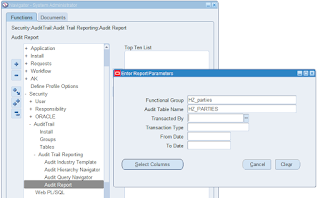History of Oracle and its ERP Versions
Oracle Corporation was co-founded by Ellison and Bob Miner
and Ed Oates in 1977 under the name Software Development Laboratories (SDL).
In 1979 SDL changed its name to Relational Software, Inc.
(RSI).
In 1982, RSI renamed itself Oracle Systems Corporation to
align itself more closely with its flagship product Oracle Database.
At this stage Bob Miner served as the company's senior
programmer.
In 1995, Oracle Systems Corporation changed its name to
Oracle Corporation.
On March 12, 1986: Oracle gone public with revenues of $55
million USD.
Oracle E-Business Suite started life as Oracle Financials in
1987.
August 1987: Oracle founds its Applications division,
building business-management software closely integrated with its database
software.
Oracle Corporation acquired TCI for its project management
software.
October 1987: Oracle Applications Release 1
Sometime in August 1988 they released their first ERP
application called accounting system that has only general Ledger functionality
enabled.
This is one of the reason of having General ledger
application_id is 101.
November 1988: Release 3
January 1989: Release 4
May 1989: Release 5
October 1989: Release 6
May 1990: Release 7
November 1990: Release 8
June 1992: Release 9
1995: Release 10
Release 10 Sub versions are 10.7NCA, 10.7.16.1, 10.7
April 1998: Release 11
Release 11 sub versions are 11.0, 11.0.1, 11.0.2, 11.0.3
July 16, 1998: First combined production installation of
Oracle Applications Release 10.7 NCA at Leeson Electric Corporation.
May 1999: Release 11.0.3
May 2000: Release 11.5.1
11i Sub Versions are 11.5, 11.5.1, 11.5.2, 11.5.3, 11.5.4,
11.5.5, 11.5.6, 11.5.7, 11.5.8, 11.5.9, 11.5.10.0, 11.5.10.1, 11.5.10.2.
Oct 2000: Release 11.5.2
Jan 2001: Release 11.5.3
Jun 2001: Release 11.5.4
Sep 2001: Release 11.5.5
Jan 2002: Release 11.5.6
May 2002: Release 11.5.7
Nov 2002: Release 11.5.8
Jun 2003: Release 11.5.9
Nov 2004: Release 11.5.10
Feb 2006: Release 11.5.10.2
Jan 2007: Release R12.0.0
R12 Sub Versions are 12.0.0, 12.0.1, 12.0.2, 12.0.3, 12.0.4,
12.0.5, 12.0.6, 12.0.7, 12.1, 12.1.1, 12.1.2, 12.1.3 and latest version is
R12.2.2 31
26th Apr 2007: R12.0.1 Released
18th Jul 2007: R12.0.2 Released
16th Oct 2007: R12.0.3 Released
15th Jan 2008: R12.0.4 Released
7th Nov 2008: R12.0.6 Released
4th May 2009: R12.1.1 Released
17th Dec 2009: R12.1.2 Released
20th Aug 2010: R12.1.3 Released
19th Sep 2013: R12.2 (R12.2.1) Released
20th Sep 2013: R12.2.2 Released
16th Dec 2013: R12.2.3 Released
And so on….







